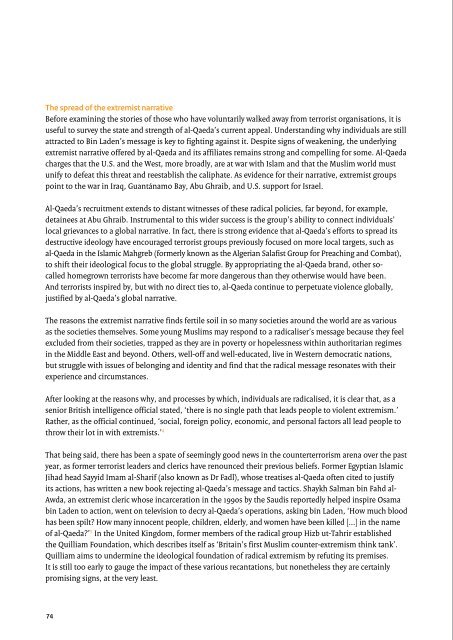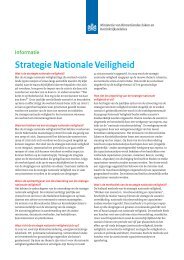Countering Violent Extremist Narratives
Countering Violent Extremist Narratives
Countering Violent Extremist Narratives
- No tags were found...
Create successful ePaper yourself
Turn your PDF publications into a flip-book with our unique Google optimized e-Paper software.
The spread of the extremist narrativeBefore examining the stories of those who have voluntarily walked away from terrorist organisations, it isuseful to survey the state and strength of al-Qaeda’s current appeal. Understanding why individuals are stillattracted to Bin Laden’s message is key to fighting against it. Despite signs of weakening, the underlyingextremist narrative offered by al-Qaeda and its affiliates remains strong and compelling for some. Al-Qaedacharges that the U.S. and the West, more broadly, are at war with Islam and that the Muslim world mustunify to defeat this threat and reestablish the caliphate. As evidence for their narrative, extremist groupspoint to the war in Iraq, Guantánamo Bay, Abu Ghraib, and U.S. support for Israel.Al-Qaeda’s recruitment extends to distant witnesses of these radical policies, far beyond, for example,detainees at Abu Ghraib. Instrumental to this wider success is the group’s ability to connect individuals’local grievances to a global narrative. In fact, there is strong evidence that al-Qaeda’s efforts to spread itsdestructive ideology have encouraged terrorist groups previously focused on more local targets, such asal-Qaeda in the Islamic Mahgreb (formerly known as the Algerian Salafist Group for Preaching and Combat),to shift their ideological focus to the global struggle. By appropriating the al-Qaeda brand, other socalledhomegrown terrorists have become far more dangerous than they otherwise would have been.And terrorists inspired by, but with no direct ties to, al-Qaeda continue to perpetuate violence globally,justified by al-Qaeda’s global narrative.The reasons the extremist narrative finds fertile soil in so many societies around the world are as variousas the societies themselves. Some young Muslims may respond to a radicaliser’s message because they feelexcluded from their societies, trapped as they are in poverty or hopelessness within authoritarian regimesin the Middle East and beyond. Others, well-off and well-educated, live in Western democratic nations,but struggle with issues of belonging and identity and find that the radical message resonates with theirexperience and circumstances.After looking at the reasons why, and processes by which, individuals are radicalised, it is clear that, as asenior British intelligence official stated, ‘there is no single path that leads people to violent extremism.’Rather, as the official continued, ‘social, foreign policy, economic, and personal factors all lead people tothrow their lot in with extremists.’ 4That being said, there has been a spate of seemingly good news in the counterterrorism arena over the pastyear, as former terrorist leaders and clerics have renounced their previous beliefs. Former Egyptian IslamicJihad head Sayyid Imam al-Sharif (also known as Dr Fadl), whose treatises al-Qaeda often cited to justifyits actions, has written a new book rejecting al-Qaeda’s message and tactics. Shaykh Salman bin Fahd al-Awda, an extremist cleric whose incarceration in the 1990s by the Saudis reportedly helped inspire Osamabin Laden to action, went on television to decry al-Qaeda’s operations, asking bin Laden, ‘How much bloodhas been spilt? How many innocent people, children, elderly, and women have been killed [...] in the nameof al-Qaeda?’ 5 In the United Kingdom, former members of the radical group Hizb ut-Tahrir establishedthe Quilliam Foundation, which describes itself as ‘Britain’s first Muslim counter-extremism think tank’.Quilliam aims to undermine the ideological foundation of radical extremism by refuting its premises.It is still too early to gauge the impact of these various recantations, but nonetheless they are certainlypromising signs, at the very least.Four lessons learned for crafting a succesful counter-narrative1. Undermine terrorist leadershipAs with the radicalisation process, which seems to differ from person to person, there is not one clearoverarching reason why individuals have walked away from terrorist organisations. The reasons for achange of heart can be strikingly prosaic: family, money, petty grievances. But they can also revolvearound shaken ideology or lost faith in a group’s leadership. Among such varied reasons, however,several common themes emerge when examining why different dropouts have left terrorist organisations.Governments may be able to take advantage of the knowledge of these trends to better formulate appropriatecounter-narratives.In studying the various terrorist dropout cases, it seems clear that ‘Naming and Shaming’, or underminingterrorist and extremist leadership, should constitute one part of the approach. Crafting messages thatsignificantly detract from leaders’ authority and credibility is vital. A general lack of respect for a group’sleadership has often been a factor in dropping out of terrorist organisations. Essam al-Ridi, an Egyptianveteran of the 1980s jihad against the Soviets, testified during the 1998 East African embassy bombings trialthat he resented taking battlefield orders from bin Laden and others who lacked military experience duringthe Afghan jihad. The decisive factor for al-Ridi’s change of perspective was in a battle in which many jihadisdied – in his view needlessly – as a result of inept leadership. In this battle, al-Qaeda declared a victorynonetheless. Al-Ridi has stated, ‘[m]y judgment as a person living here, not in the hereafter, is that this ispure killing. If you don’t know what you’re doing, you are killing your people [...] I became more angry andmore opposing what’s happening in Afghanistan and what’s happening to Osama and how he became aleader of his own.’ 6Ziad Jarrah, one of the 9/11 hijackers, was unhappy with Mohammed Atta’s leadership while the 19 plotterswere in the U.S., and the two often clashed. Jarrah had been on his own for most of his time in the U.S.before 9/11 and strongly resisted Atta’s attempts to exert more direct control. At least in part due to hisproblems with Atta, Jarrah, who eventually became the hijacker pilot on the United 93 flight, wascontemplating dropping out of the plot during the summer of 2001. In an emotional conversation, RamziBinalshibh – the Hamburg-based liaison between the cell plotting the 9/11 attacks and al-Qaeda’s seniorleadership in Afghanistan – persuaded Jarrah to stay.Noman Benotman, the former leader of the al-Qaeda-affiliated Libyan Islamic Fighting Group (LIFG), alsoturned his back on the terrorist cause, abandoning not only LIFG but al-Qaeda as well. 7 Benotman had realdifferences with bin Laden over the direction of the global jihadist movement, and Benotman claims tohave asked the al-Qaeda Emir to leave behind the terrorism business in 2000, contending that they werefighting a losing battle. After 9/11, Benotman resigned from his position in LIFG, concerned that the U.S.would likely respond to the attack by targeting both al-Qaeda and his own organisation. 8Perhaps then, the U.S. efforts to undermine AQI leader Abu Musab al-Zarqawi by showing a video whichmade clear that he did not know how to handle a gun was potentially effective. Taking steps to avoidbuilding up the reputations of terrorist leaders also likely has merit as a counter-narrative. For example,before 9/11, President Clinton said that he tried to avoid mentioning bin Laden’s name too often in orderto avoid making him a bigger hero in some parts of the world than he already was.74 75
















